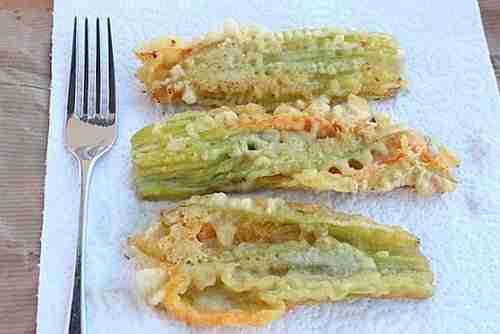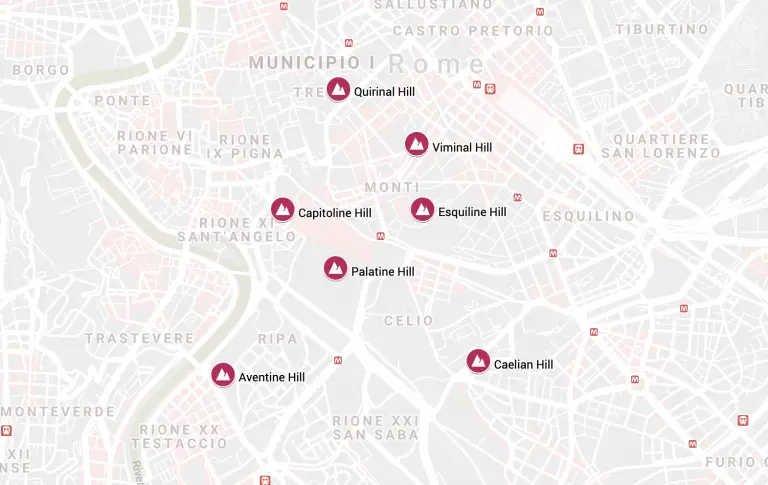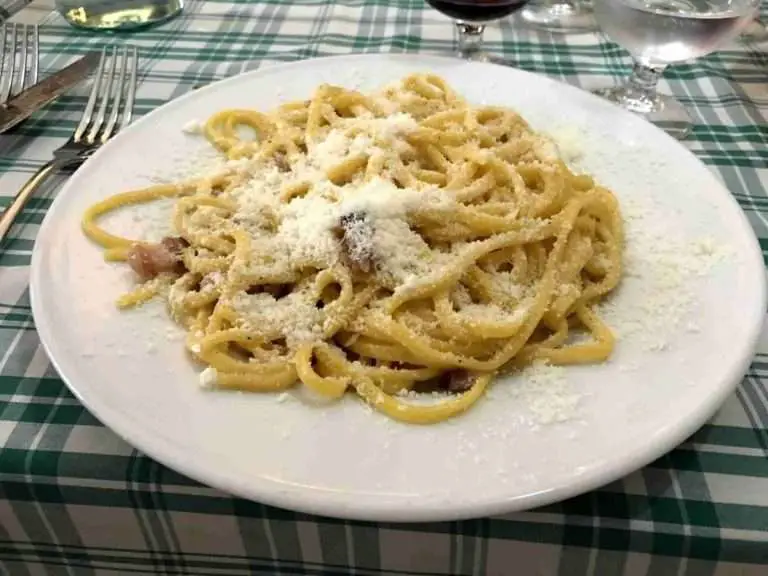
Eleonora Baldwin writes not one, but two food blogs – one in English and the other in Italian. I’m very excited that this native Roman wanted to share with Italofile readers her five favorite recipes from Rome. And you don’t have to wait to go to Rome to try these, as Eleonora has provided recipes!
I’m a favorites freak. I have favorites in every category – authors, colors, artists, foods, cities, wines, bands, movies – you name it. So imagine how excited I was to participate in Italofile’s fabulous feature Five Favorites.
And since I am a Roman citizen, and among my favorite activities are eating, cooking, writing, and traveling, here are my Five Favorite Roman Dishes, listed in dream-menu order starting with an antipasto, followed by a starchy opener, a protein entrée, a delicious veggie side dish, and a non-sweet meal ending. All of these are traditional and authentic recipes hailing from the Eternal City. Shall we begin? Unfold your napkin and prepare to salivate.
Fiori di Zucca Fritti – Fried Zucchini Blossoms

Fried zucchini blossoms
There have been millions of words written on the zucchini flower. The forerunner of the ever-burgeoning mottled cylinders, are edible. More than edible, they’re delicious! That which some just chuck away as waste, can in fact become a delectable antipasto, part of a pasta condiment or even a salad element. Gather those blossoms while you can and prepare for yet another true Roman taste bud epiphany.
Fiori di Zucca Fritti Recipe
- 15 zucchini flowers
- 4 salted anchovy fillets (optional)
- 200 gr (1 cup) mozzarella, diced
- 100 gr (1/2 cup) unbleached all purpose flour
- Oil for frying
- Salt
Trim pistils and stems off the flowers, paying extra attention not to break them, they are quite delicate. Wash carefully with water and baking soda, rinse with plenty cold water and pat dry with paper towel.
Cut the mozzarella in strips and finely chop the anchovies (if you’re using them). Stuff each blossom with some mozzarella and a dab of anchovy mash and uncork a bottle of white Colli Albani wine.
In a mixing bowl, blend a 1/2 glass (or more) of chilled sparkling water, flour and salt until fluffy and add a dash of beer or a pinch of baking soda for an even more lightweight batter.
Dip the stuffed flowers in the batter open side up and deep fry in scalding olive oil. Briefly park on paper towel and serve hot with the remaining wine, if any is left.
Bucatini Cacio e Pepe

Bucatini Cacio e Pepe
This typical Roman pasta dish is a simple cheese and pepper combination hallmark of Testaccio, the ancient housing project development and ex meat slaughtering district in the southern section of the Peninsula’s capital. Cacio e Pepe is particularly suited as a rewarding quick fix for self-invited last minute guests or post-fornication midnight munchies.
Bucatini Cacio e Pepe Recipe
- 500 gr (1 lb) bucatini, thick hollow noodles. They can be substituted with virtually any ribbed or long strand pasta (in U.S. supermarkets, look for perciatelli if you can’t find bucatini -MMR)
- 1/2 cup sharp Roman Pecorino cheese, grated
- 1 cup Parmigiano Reggiano, grated
- Lots of freshly ground black pepper
Cook the pasta al dente in 1 gallon of lightly salted boiling water. Drain and save some cooking water for later. Toss with the grated cheeses and pepper, blending well and if necessary adding some starchy cooking water, should they become too thick and dry.
Devour at tongue-burning temperature and revel.
Editor’s Note: Several years after Eleonora wrote this post, she hosted the show A, B, Cheese on the Italian food and cooking channel Gambero Rosso. Here is a video of her making Cacio e Pepe at Da Enzo, a beloved trattoria in Rome.
Saltimbocca alla Romana

Saltimbocca alla Romana
Roman-style “jump in the mouth” cutlets whose name is remarkably appropriate–you can never eat enough of these deliciously tender veal cutlets topped with prosciutto and sage.
Saltimbocca alla Romana Recipe
Serves a hungry 2 (or regular appetite 4)
- 500 gr (1.1 lb) lean veal, cut into 8 thin playing card-sized scaloppine
- 60 gr (2 oz) prosciutto, cut into wafer-thin slices, about 4
- Unsalted butter for sautéing
- 8 Fresh sage leaves
- Dash of salt
- Wooden toothpicks
If your butcher was lazy when he carved the veal and your slices are too thick, hammer them with a kitchen cleaver held flat. Lay half a slice of prosciutto on each, and a sage leaf. Fasten these to the veal cutlet with one or two toothpicks.
Heat a couple tablespoons of unsalted butter in a skillet and sauté the cutlets until just done, cooking them more on the veal side than the decorated side (salty, overcooked prosciutto tends to become leathery). Season your saltimbocca to taste and hop them in your mouth, along with their savory drippings.
Puntarelle

Puntarelle
Puntarelle are the sprouts of a chicory variety called cicoria di catalogna, puntarelle chicory, or asparagus chicory, picked while still young and tender. They are in season from November to January.
The preparation of this salad is a little complex, fortunately puntarelle are sold in Rome’s farmers’ and corner markets already trimmed and “curled”.
The sprouts and shoots of the puntarelle are cut lengthwise into long, thin strips and soaked in acidulated ice-cold water for an hour. This causes the crunchy pale green chicory to curl up in extraordinary Shirley Temple-style curls, become juicier and less bitter. The recipe for the punchy dressing of this very particular salad dates back to ancient Rome.
Puntarelle Recipe
Assemble the following ingredients for a taste of true Roman flavor.
- 1 kg (2.2 lbs) puntarelle (can be substituted with Belgian endive or the youngest curly chicory you can find)
- 8 anchovy fillets packed in salt, cleaned (can be substituted with regular oil-preserved anchovies)
- 3-4 garlic cloves, minced
- The juice of 1/2 lemon
- Extra virgin olive oil
- Salt & pepper to taste
Prepare a creamy pesto with minced garlic, anchovies, splash of lemon juice (not too much!) very little salt, pepper and plenty olive oil. Pestle and mortar would be best, but if you use a mezzaluna or a kitchen knife to chop finely and then mix with a wire whisk, I won’t tell anyone. Stir and allow the dressing to sit for 10 minutes.
Drain the puntarelle, dry with a kitchen towel or spin-dry carefully. Trickle the obtained velvety beige dressing over the chilled and curled puntarelle salad, toss, allow it to sit for another few minutes, and expect to face reduced social life for the next 3 days (garlic).
Note: If you’re particularly in a rush and decide to use anchovy paste instead of fillets, just cut down on the salt and–again–count on my discretion.
Fave & Pecorino

Fresh Fave (Fava Beans) 
Pecorino
April 25th and May 1st are very important Italian National holidays. One celebrates the Country’s liberation day after 20 years of fascism, and the other is Italian Labor Day. On both dates all activity stops, newspapers don’t go into press, all business shuts down, and people migrate to nearby rural locations laden with copious amounts of packed picnic food.
Bucolic folly and loud outdoor snoring are a must because the milder climate, blooming vegetation, and diffused hormone surge make a pastoral occasion on such holidays a necessity. Families and friends make for their countryside destinations loading their cars with picnic tablecloths, soccer balls, and baskets of Pantagruelian delicacies, which require among them large amounts of fresh fava beans (fave) and sharp Roman Pecorino cheese.
The tangy crunch of the raw beans and the aggressive dairy combo is downright divine. It is a synonym of Roman spring. And quite a potent digestive too!
Buon appetito!
About the Author

When she’s not shooting on location around the world on a film set as script supervisor–or writing a food/travel column–you’ll most probably find Eleonora (Lola) Baldwin busy cooking in her Rome kitchen. Eleonora is currently editing her Italian cookbook/lifestyle manuscript, and is the author/editor of two popular weblogs: AGLIO, OLIO & PEPERONCINO, focuses on Italian cuisine, food history, travel musings, and local hang-outs. FORCHETTINE, written in Italian, is a food-lover’s online guide in which the author reviews restaurant facilities and regional specialties in Italy. You can also follow Eleonora on Twitter @passerotto.
More Roman Recipes
Explore the world of Roman cuisine with these two Roman cookbooks:
Photos © francescav, madgrin, frabattista, su-lin, Italian Notebook
Last updated on May 17th, 2023Post first published on December 18, 2009








